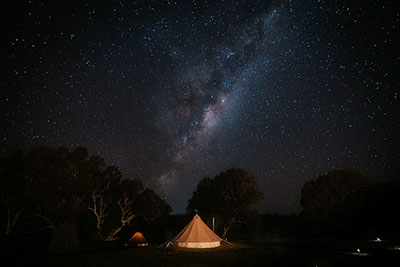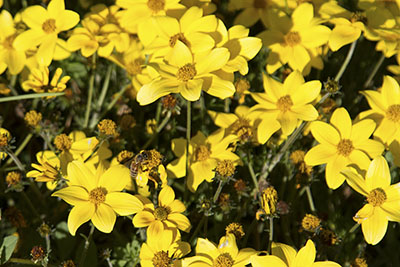Permaculture principles: how to apply them to your travels
The 12 Permaculture Principles are great tenets to live by. You can apply them to just about any facet of your life – including your travels.

When many people hear the word ‘permaculture’ (if they even know what it is to begin with), they often associate it with farming or gardening.
Permaculture is so much more than this.
The movement is guided by 12 principles, which you can apply to many different parts of life. Social, behavioural, whichever; permaculture’s got you.
If you’re a keen traveller, you can even let the principles guide how you travel.
And by doing this, you can become a more informed and conscious traveller – doing good by the world and giving back as you experience it.
Let’s break the 12 principles down and see how they can be applied to travel.
Applying the permaculture principles to travel
So here’s how we’ll lay this out.
We’ll go through each of the twelve Permaculture Principles and see how we can use them in our travels.
You might find some ideas below overlap with different principles; this is completely fine! Part of the beauty of permaculture is how everything works together.
An article that might be helpful to read alongside this is my guide to responsible tourism.
1. Observe & interact

Beauty is in the eye of the beholder
As you might have guessed, this particular permaculture goal is all about spending time in and appreciating nature.
Each permaculture principle has its own proverb. This one reminds us that we see value in, well, what we see. In nature however, there’s no such thing as ‘right’ or ‘wrong’.
Some examples of this principle while travelling could be:
- watching wildlife in their natural habitat and leaving them in peace
- while hiking, observing the sights from the marked paths and not stepping off trail to trample precious vegetation
- interacting with the local community while travelling; perhaps eating at a local hotspot, asking for recommendations or buying souvenirs that are handcrafted
- finding a quiet spot; in nature or even in the midst of a busy city. Sitting and watching life go on around you.
2. Catch & store energy

Make hay while the sun shines
This principle relates to storing energy for later use, whether this be literal energy like electricity or heat, or storing food and produce for later use.
The proverb reminds us that the opportunity to store energy is usually finite.
Try:
- using a solar powered charging bank
- staying in eco-friendly accommodation that uses solar energy, collects rainwater, composts their food waste, etc
- storing boiled water in a thermos for later use
- likewise, not needlessly using energy – heat yourself up with layers, and turn off lights and air-conditioning when you leave a hotel room
- if you like to cook while you travel, source seasonal produce from farmers’ markets and community gardens
- taking a container with you when eating out, to take leftovers for later, or to compost food waste.
3. Obtain a yield

You can’t work on an empty stomach
This permaculture principle when applied to travel, really means living in the moment. Or rather, you get out of an experience what you put into it.
Travel can be transformative. It opens your eyes to the world, whether in a good or bad way.
Once I return home, I usually do so with a greater appreciation for my lot in life.
And while you travel, consider:
- researching tour operators and companies that don’t harm the land they live on and communities they work in
- volunteering; plant trees for a day, do a beach clean up in return for good feels or consider WWOOFING, where you exchange farm work for meals and board
- bringing back keepsakes of your travels; whether that be memories you can turn to when things at home or tough, photographs, or physical reminders.
4. Apply self-regulation & accept feedback

The sins of the fathers are visited unto the children of the seventh generation
This permaculture principle is so relevant for our times, where global warming is rampant. As a species, we’re fouling our own nest and not considering what we’re leaving for future generations.
The blame for this lies at the feet of governments who are slow to act (or just don’t care) and businesses and conglomerates that care more about their profits than taking care of the world we live in.
However, there are small things you can do in your own travels to embody this principle:
- try your best to be a good traveller. It’s okay to not be perfect, but learn from your mistakes
- forgo country counting for slow travel, or spend more time exploring your own backyard
- look for ways to travel that emit less carbon. Take trains, buses, ferries or carpool rather than flying where possible
- consider where your tourist dollars are going and how they can be best spent
- don’t contribute to overtourism – consider places that are a bit off the beaten path (you’ll have a better travel experience for it, trust me).
5. Use & value renewable resources & services

Let nature take its course
Nature has a abundance of gifts to give us, if only we open ourselves up to this. And much of this abundance has multiple uses.
To me, this is about looking to resources that are already there and can be used again and again.
So, how can we apply this to our travels? Well:
- if possible, dry any washing in the sun rather than at a laundromat
- learn about regenerative farming and see if there are any examples you can visit in your travels
- eat at a restaurant that values the farm-to-table experience, or serves produce from their kitchen garden
- pick up a new skill while travelling. Perhaps take a cooking class in the local cuisine, learn how to carve wooden spoons, ferment, or tan a hide.
6. Produce no waste

A stitch in time saves nine
Waste not, want not
This is one of my favourite permaculture principles, as it’s a great one to start with.
It’s all about seeing the value in items around you and ensuring nothing goes to waste. As after all – waste is not waste, until we waste it.
This is the first principle I started my journey with, before I even knew what permaculture was. I gave up plastic for a year, while living overseas and travelling often.
Here are some ideas to get you started:
- shop for travel clothes and items secondhand; at op/charity shops or online through Gumtree, Freecycle, Facebook Marketplace, etc
- or borrow what you need for travel from family in friends, in exchange for a gift or bottle of wine
- learn how to sew to fix holes in clothes and darn old socks to give them a second life
- ditch the plastic for a reusable water bottle, filtered if need be
- similarly, consider investing in eco-friendly travel items, rather than disposable crap.
7. Design from patterns to details

Can’t see the forest for the trees
Sometimes you have to step back from something to see the full picture. And that’s exactly what this permaculture principle relates to.
A lot of us see our lives as being separate to nature, thanks to our increasingly urban lifestyles.
However; many of our cities have wild elements to them. Both London and Melbourne for example, can be classified as forests.
Look for nature and adventure in the place where you life; you might be pleasantly surprised.
You can also:
- spend time with trees, whether that be in the bush, forest or urban trees. They literally give us air to breathe, yet we appreciate them so little
- visit gardens around the world and spend time in National Parks
- look for patterns in nature; the web of a spider, the canopy of trees and see how everything fits together
- use travel as a reset button, an opportunity to take stock of your life. Are you where you want to be? What can you do to help your local community, your city, the planet?
8. Integrate rather than segregate

Many hands make light work
Put simply, this principle suggests that we achieve when we work together collectively. Think of a hive of bees, working together to produce delicious honey.
An ecosystem thrives, if everything and everyone plays their part.
Some ways you can use this principle while travelling includes:
- thanking service staff and tipping where culturally appropriate
- does the place you’re visiting have an indigenous culture? Can you learn more about it, whether that be through reading, or taking a tour led by indigenous peoples?
- staying somewhere where you can meet people, such as hostels
- or consider jumping on an ethical tour, that prioritises the needs of the local community.
9. Use small & slow solutions

The bigger they are, the harder they fall
Slow and steady wins the race
This is another principle that is great to consider in the current context of our world.
We collectively value growth. We want things immediately. Instant gratification!
This principle reminds us that the journey is an integral part of the process. And we don’t necessarily need to think big – sometimes the best solution to an issue is small and simple.
Here are some ideas of how to use this principle in your travels:
- get to know your own backyard. People will often travel extensively overseas, while ignoring their home country. There’s plenty of adventure to be had where you live, if you open yourself to it
- again, embrace slow travel. Rather than flying to a destination for a long weekend, or country hopping, stay a little longer if you can and get to know it better
- enjoy the process of planning your travels. Research the places you’re going to. Plan an itinerary. Delight in the process of saving for your trip. It helps build anticipation, helps you appreciate the time spent away more.
10. Use & value diversity

Don’t put all your eggs in one basket
This principle reminds us that it’s great to branch out.
I also see it as a reminder to open your eyes to the world around you; cultures that may be different to yours, different ways of living.
It helps enrich your life. Here are some ideas:
- be adventurous in your eating while you travel. Consume the colours of the rainbow and don’t be afraid to try local cuisines – particularly bugs
- likewise, consider embracing foraging. I live in Australia, where you can do tours to learn about ‘bush tucker’, but similarly, urban foraging is growing in popularity. Start with an expert and branch off from there
- learn how the communities you visit grow their food. I found the Svalbard Global Seed Vault to be highly fascinating.
11. Use edges & value the marginal

Don’t think you are on the right track just because it’s a well-beaten path
To me, this is the quirkiest principle; valuing originality.
Most people who are into permaculture do tend to march to the beat of their own drum, so if anything, this is a bit of validation!
It’s often when we break away from the ‘hive-mind’ that inspirations strikes. Don’t let fear dictate what you do, especially on your travels.
Consider:
- again; travel off the beaten path! Go to places others don’t go, whether it be cities or countries. Travel in the off season rather than peak summer
- similarly, look for unique experiences. My favourite travel memories include taking a llama for a walk and camping in a desert
- avoid staying in AirBnBs, especially in cities
- learn about the history of the places you visit, their traditions and skills
- immerse yourself in local culture, where you can. Learn some of the language, even if it’s a few key phrases. Take part in cultural practices and festivals, if you’re invited to. And above all, be respectful.
12. Creatively use & respond to change

Vision is not seeing things as they are but as they will be
One for all the creative thinkers out there! You can have a lot of fun with this permaculture principle, especially when it comes to travel.
It’s all about being a bit of a dreamer. What’s that saying? Be the change you want to see in the world? That’s this principle in a nutshell.
Some ways you can do this while travelling include:
- consider art as activism, particularly if you sketch while travelling or illustrate your travel journals
- grab groceries while on the road from bulk food stores
- or shop fresh food at local markets
- stay in tiny houses or similarly quirky and eco-friendly abodes
- look for permaculture farms you can visit or stay at on your travels.
Permaculture principles & travel: in conclusion
As you’ve now read, it is possible to use the 12 permaculture principles in your travels around the world.
I highly recommend it! My life has certainly got much more fun since I found permaculture (or rather, it found me), and it’s definitely helped with managing eco-anxiety.
I hope you’ve found this article helpful. For similar musings, consider signing up for my newsletter.
What are your thoughts on permaculture? Any ideas on how you’d apply the principles to your travels? I’d love to hear some ideas in the comments.
After more content like this? I’ve got plenty:
- 20 best books about walking
- 40+ sustainable travel tips to make you a better traveller
- An extensive guide to zero waste travel
- Ways you can give back to the planet while travelling







